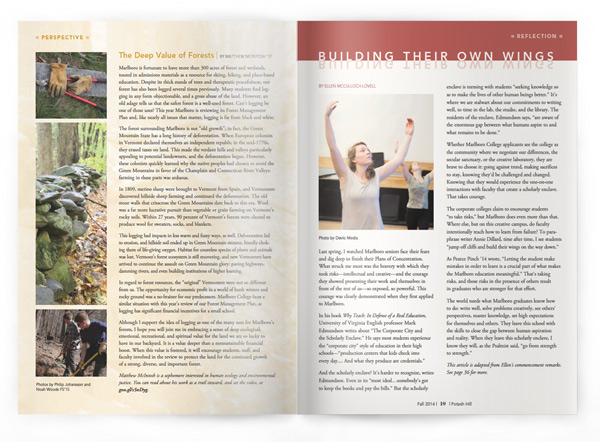The Deep Value of Forests

Perspective
By Matthew McIntosh ’17

Marlboro is fortunate to have more than 300 acres of forest and wetlands, touted in admissions materials as a resource for skiing, hiking, and place-based education. Despite its thick stands of trees and therapeutic peacefulness, our forest has also been logged several times previously. Many students find logging in any form objectionable, and a gross abuse of the land. However, an old adage tells us that the safest forest is a well-used forest. Can’t logging be one of those uses? This year Marlboro is reviewing its Forest Management Plan and, like nearly all issues that matter, logging is far from black and white.
The forest surrounding Marlboro is not “old growth”; in fact, the Green Mountain State has a long history of deforestation. When European colonists in Vermont declared themselves an independent republic in the mid-1770s, they erased taxes on land. This made the verdant hills and valleys particularly appealing to potential landowners, and the deforestation began. However, these colonists quickly learned why the native peoples had chosen to avoid the Green Mountains in favor of the Champlain and Connecticut River Valleys: farming in these parts was arduous.
In 1809, merino sheep were brought to Vermont from Spain, and Vermonters discovered hillside sheep farming and continued the deforestation. The old stone walls that crisscross the Green Mountains date back to this era. Wool was a far more lucrative pursuit than vegetable or grain farming on Vermont’s rocky soils. Within 27 years, 90 percent of Vermont’s forests were cleared to produce wool for sweaters, socks, and blankets.
This logging had impacts in less warm and fuzzy ways, as well. Deforestation led to erosion, and hillside soil ended up in Green Mountain streams, literally choking them of life-giving oxygen. Habitat for countless species of plants and animals was lost. Vermont’s forest ecosystem is still recovering, and new Vermonters have arrived to continue the assault on Green Mountain glory: paving highways, damming rivers, and even building institutions of higher learning.
In regard to forest resources, the “original” Vermonters were not so different from us. The opportunity for economic profit in a world of harsh winters and rocky ground was a no-brainer for our predecessors. Marlboro College faces a similar situation with this year’s review of our Forest Management Plan, as logging has significant financial incentives for a small school.
Although I support the idea of logging as one of the many uses for Marlboro’s forests, I hope you will join me in embracing a sense of deep ecological, emotional, recreational, and spiritual value for the land we are so lucky to have in our backyard. It is a value deeper than a nonsustainable financial boost. When this value is fostered, it will encourage students, staff, and faculty involved in the review to protect the land for the continued growth of a strong, diverse, and important forest.
Matthew McIntosh is a sophomore interested in human ecology and environmental justice. You can read about his work as a trail steward, and see the video, at his profile.
